Evidence-Based Healthcare Management: Solutions to Medication Errors
VerifiedAdded on 2023/06/04
|9
|2033
|341
Essay
AI Summary
This essay addresses the critical issue of medication errors in healthcare facilities, particularly within the USA, and explores potential solutions. Medication errors, defined as mistakes that can harm or lead to patient death, can occur during prescription or drug administration. The essay evaluates three peer-reviewed sources that investigate these solutions, assessing their credibility and validity. Key solutions identified include simplifying medication processes, reducing hand-offs, standardizing operations, and implementing computerized systems. The importance of training healthcare providers, applying constraints to prevent errors, optimizing work schedules and environments, improving communication, and involving patients in their treatment plans are also discussed. The analysis emphasizes the need for healthcare facilities to adopt these evidence-based recommendations to minimize clinical mistakes and enhance patient safety, ensuring better healthcare outcomes.
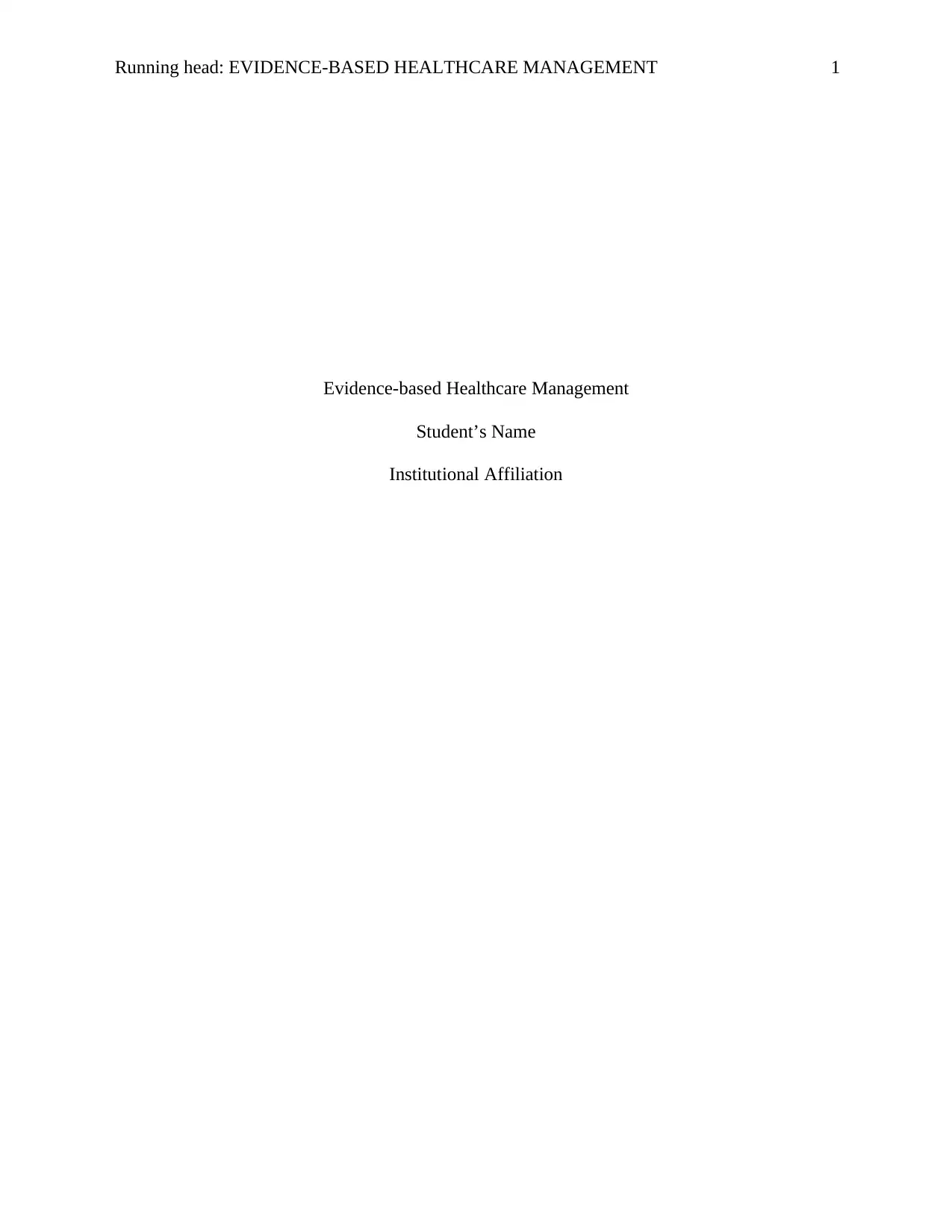
Running head: EVIDENCE-BASED HEALTHCARE MANAGEMENT 1
Evidence-based Healthcare Management
Student’s Name
Institutional Affiliation
Evidence-based Healthcare Management
Student’s Name
Institutional Affiliation
Paraphrase This Document
Need a fresh take? Get an instant paraphrase of this document with our AI Paraphraser
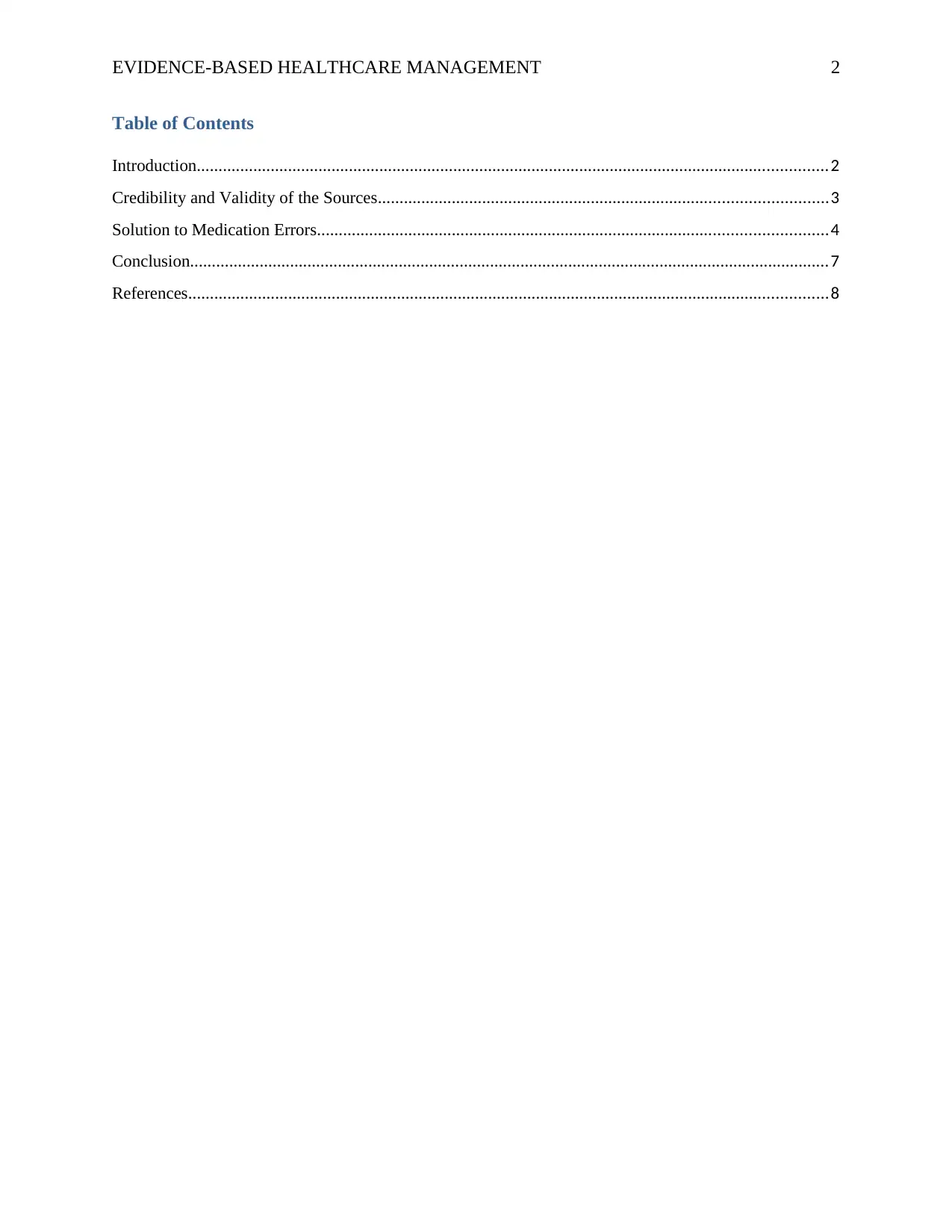
EVIDENCE-BASED HEALTHCARE MANAGEMENT 2
Table of Contents
Introduction.................................................................................................................................................2
Credibility and Validity of the Sources.......................................................................................................3
Solution to Medication Errors.....................................................................................................................4
Conclusion...................................................................................................................................................7
References...................................................................................................................................................8
Table of Contents
Introduction.................................................................................................................................................2
Credibility and Validity of the Sources.......................................................................................................3
Solution to Medication Errors.....................................................................................................................4
Conclusion...................................................................................................................................................7
References...................................................................................................................................................8
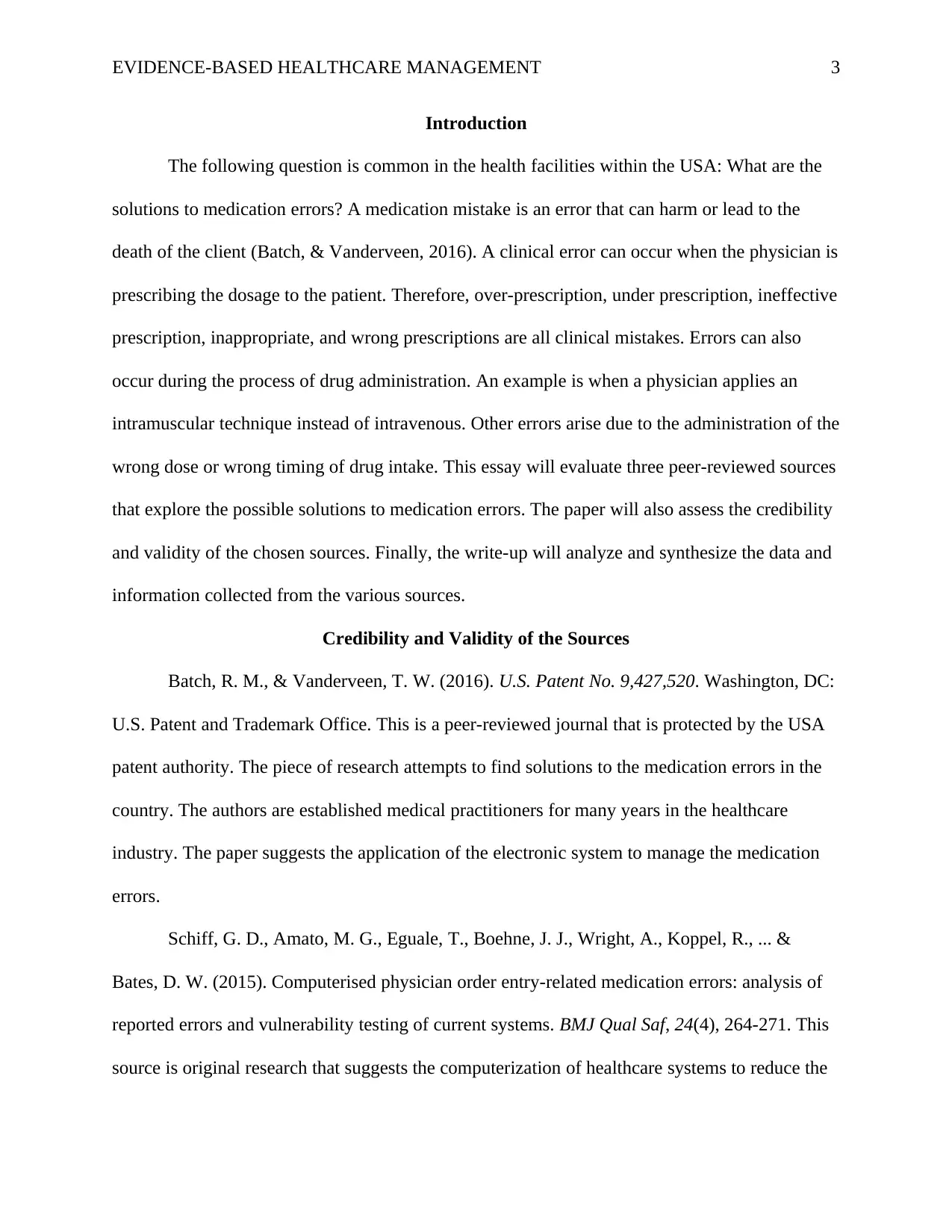
EVIDENCE-BASED HEALTHCARE MANAGEMENT 3
Introduction
The following question is common in the health facilities within the USA: What are the
solutions to medication errors? A medication mistake is an error that can harm or lead to the
death of the client (Batch, & Vanderveen, 2016). A clinical error can occur when the physician is
prescribing the dosage to the patient. Therefore, over-prescription, under prescription, ineffective
prescription, inappropriate, and wrong prescriptions are all clinical mistakes. Errors can also
occur during the process of drug administration. An example is when a physician applies an
intramuscular technique instead of intravenous. Other errors arise due to the administration of the
wrong dose or wrong timing of drug intake. This essay will evaluate three peer-reviewed sources
that explore the possible solutions to medication errors. The paper will also assess the credibility
and validity of the chosen sources. Finally, the write-up will analyze and synthesize the data and
information collected from the various sources.
Credibility and Validity of the Sources
Batch, R. M., & Vanderveen, T. W. (2016). U.S. Patent No. 9,427,520. Washington, DC:
U.S. Patent and Trademark Office. This is a peer-reviewed journal that is protected by the USA
patent authority. The piece of research attempts to find solutions to the medication errors in the
country. The authors are established medical practitioners for many years in the healthcare
industry. The paper suggests the application of the electronic system to manage the medication
errors.
Schiff, G. D., Amato, M. G., Eguale, T., Boehne, J. J., Wright, A., Koppel, R., ... &
Bates, D. W. (2015). Computerised physician order entry-related medication errors: analysis of
reported errors and vulnerability testing of current systems. BMJ Qual Saf, 24(4), 264-271. This
source is original research that suggests the computerization of healthcare systems to reduce the
Introduction
The following question is common in the health facilities within the USA: What are the
solutions to medication errors? A medication mistake is an error that can harm or lead to the
death of the client (Batch, & Vanderveen, 2016). A clinical error can occur when the physician is
prescribing the dosage to the patient. Therefore, over-prescription, under prescription, ineffective
prescription, inappropriate, and wrong prescriptions are all clinical mistakes. Errors can also
occur during the process of drug administration. An example is when a physician applies an
intramuscular technique instead of intravenous. Other errors arise due to the administration of the
wrong dose or wrong timing of drug intake. This essay will evaluate three peer-reviewed sources
that explore the possible solutions to medication errors. The paper will also assess the credibility
and validity of the chosen sources. Finally, the write-up will analyze and synthesize the data and
information collected from the various sources.
Credibility and Validity of the Sources
Batch, R. M., & Vanderveen, T. W. (2016). U.S. Patent No. 9,427,520. Washington, DC:
U.S. Patent and Trademark Office. This is a peer-reviewed journal that is protected by the USA
patent authority. The piece of research attempts to find solutions to the medication errors in the
country. The authors are established medical practitioners for many years in the healthcare
industry. The paper suggests the application of the electronic system to manage the medication
errors.
Schiff, G. D., Amato, M. G., Eguale, T., Boehne, J. J., Wright, A., Koppel, R., ... &
Bates, D. W. (2015). Computerised physician order entry-related medication errors: analysis of
reported errors and vulnerability testing of current systems. BMJ Qual Saf, 24(4), 264-271. This
source is original research that suggests the computerization of healthcare systems to reduce the
⊘ This is a preview!⊘
Do you want full access?
Subscribe today to unlock all pages.

Trusted by 1+ million students worldwide
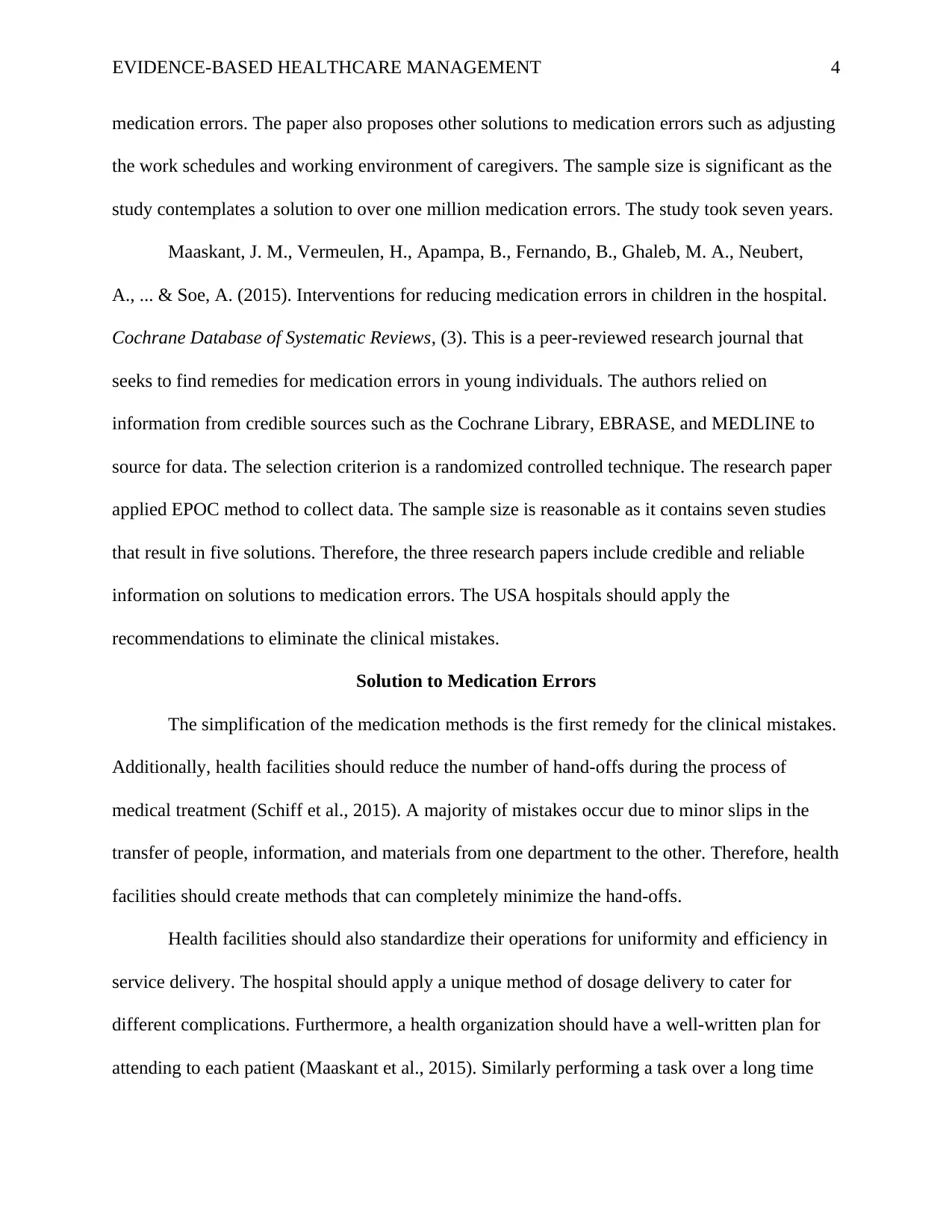
EVIDENCE-BASED HEALTHCARE MANAGEMENT 4
medication errors. The paper also proposes other solutions to medication errors such as adjusting
the work schedules and working environment of caregivers. The sample size is significant as the
study contemplates a solution to over one million medication errors. The study took seven years.
Maaskant, J. M., Vermeulen, H., Apampa, B., Fernando, B., Ghaleb, M. A., Neubert,
A., ... & Soe, A. (2015). Interventions for reducing medication errors in children in the hospital.
Cochrane Database of Systematic Reviews, (3). This is a peer-reviewed research journal that
seeks to find remedies for medication errors in young individuals. The authors relied on
information from credible sources such as the Cochrane Library, EBRASE, and MEDLINE to
source for data. The selection criterion is a randomized controlled technique. The research paper
applied EPOC method to collect data. The sample size is reasonable as it contains seven studies
that result in five solutions. Therefore, the three research papers include credible and reliable
information on solutions to medication errors. The USA hospitals should apply the
recommendations to eliminate the clinical mistakes.
Solution to Medication Errors
The simplification of the medication methods is the first remedy for the clinical mistakes.
Additionally, health facilities should reduce the number of hand-offs during the process of
medical treatment (Schiff et al., 2015). A majority of mistakes occur due to minor slips in the
transfer of people, information, and materials from one department to the other. Therefore, health
facilities should create methods that can completely minimize the hand-offs.
Health facilities should also standardize their operations for uniformity and efficiency in
service delivery. The hospital should apply a unique method of dosage delivery to cater for
different complications. Furthermore, a health organization should have a well-written plan for
attending to each patient (Maaskant et al., 2015). Similarly performing a task over a long time
medication errors. The paper also proposes other solutions to medication errors such as adjusting
the work schedules and working environment of caregivers. The sample size is significant as the
study contemplates a solution to over one million medication errors. The study took seven years.
Maaskant, J. M., Vermeulen, H., Apampa, B., Fernando, B., Ghaleb, M. A., Neubert,
A., ... & Soe, A. (2015). Interventions for reducing medication errors in children in the hospital.
Cochrane Database of Systematic Reviews, (3). This is a peer-reviewed research journal that
seeks to find remedies for medication errors in young individuals. The authors relied on
information from credible sources such as the Cochrane Library, EBRASE, and MEDLINE to
source for data. The selection criterion is a randomized controlled technique. The research paper
applied EPOC method to collect data. The sample size is reasonable as it contains seven studies
that result in five solutions. Therefore, the three research papers include credible and reliable
information on solutions to medication errors. The USA hospitals should apply the
recommendations to eliminate the clinical mistakes.
Solution to Medication Errors
The simplification of the medication methods is the first remedy for the clinical mistakes.
Additionally, health facilities should reduce the number of hand-offs during the process of
medical treatment (Schiff et al., 2015). A majority of mistakes occur due to minor slips in the
transfer of people, information, and materials from one department to the other. Therefore, health
facilities should create methods that can completely minimize the hand-offs.
Health facilities should also standardize their operations for uniformity and efficiency in
service delivery. The hospital should apply a unique method of dosage delivery to cater for
different complications. Furthermore, a health organization should have a well-written plan for
attending to each patient (Maaskant et al., 2015). Similarly performing a task over a long time
Paraphrase This Document
Need a fresh take? Get an instant paraphrase of this document with our AI Paraphraser
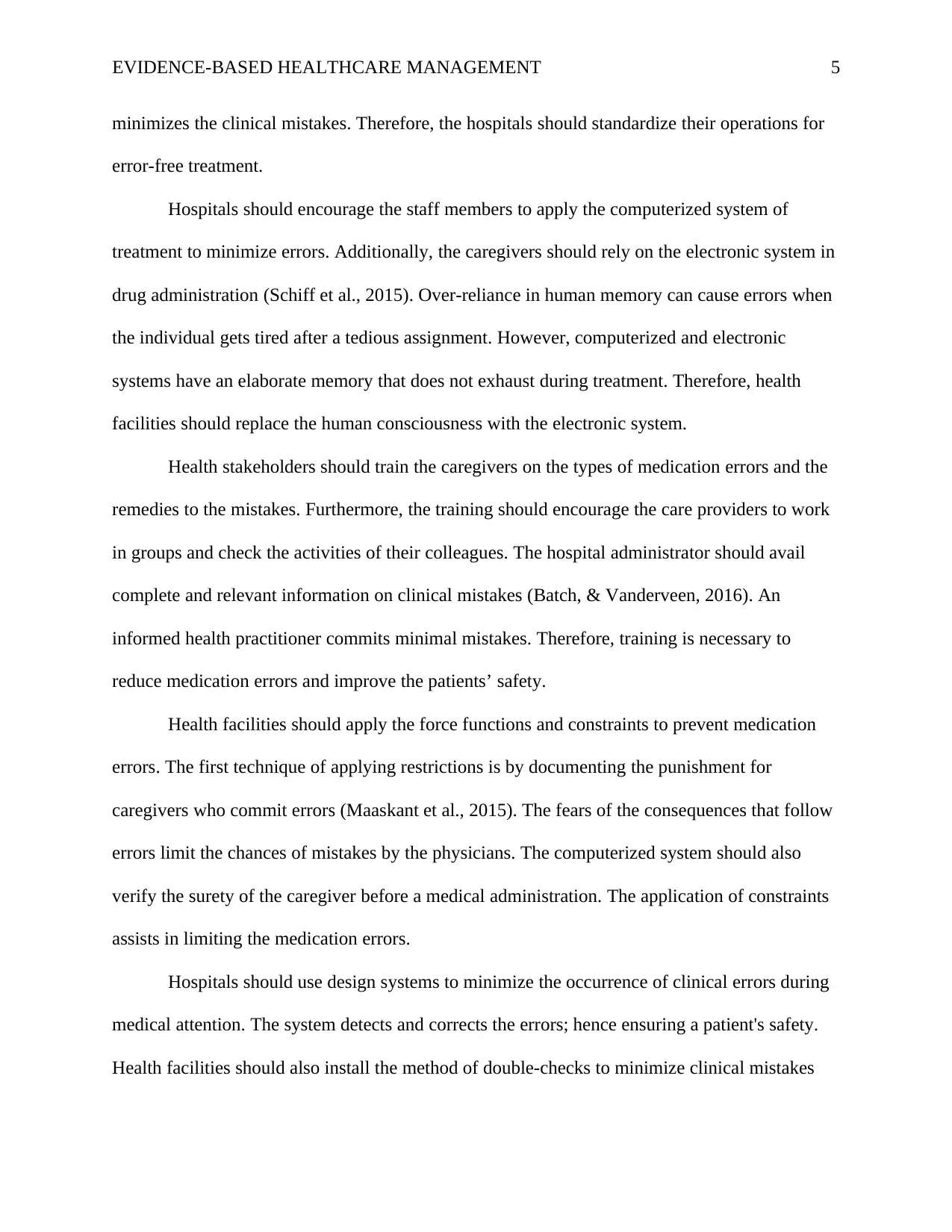
EVIDENCE-BASED HEALTHCARE MANAGEMENT 5
minimizes the clinical mistakes. Therefore, the hospitals should standardize their operations for
error-free treatment.
Hospitals should encourage the staff members to apply the computerized system of
treatment to minimize errors. Additionally, the caregivers should rely on the electronic system in
drug administration (Schiff et al., 2015). Over-reliance in human memory can cause errors when
the individual gets tired after a tedious assignment. However, computerized and electronic
systems have an elaborate memory that does not exhaust during treatment. Therefore, health
facilities should replace the human consciousness with the electronic system.
Health stakeholders should train the caregivers on the types of medication errors and the
remedies to the mistakes. Furthermore, the training should encourage the care providers to work
in groups and check the activities of their colleagues. The hospital administrator should avail
complete and relevant information on clinical mistakes (Batch, & Vanderveen, 2016). An
informed health practitioner commits minimal mistakes. Therefore, training is necessary to
reduce medication errors and improve the patients’ safety.
Health facilities should apply the force functions and constraints to prevent medication
errors. The first technique of applying restrictions is by documenting the punishment for
caregivers who commit errors (Maaskant et al., 2015). The fears of the consequences that follow
errors limit the chances of mistakes by the physicians. The computerized system should also
verify the surety of the caregiver before a medical administration. The application of constraints
assists in limiting the medication errors.
Hospitals should use design systems to minimize the occurrence of clinical errors during
medical attention. The system detects and corrects the errors; hence ensuring a patient's safety.
Health facilities should also install the method of double-checks to minimize clinical mistakes
minimizes the clinical mistakes. Therefore, the hospitals should standardize their operations for
error-free treatment.
Hospitals should encourage the staff members to apply the computerized system of
treatment to minimize errors. Additionally, the caregivers should rely on the electronic system in
drug administration (Schiff et al., 2015). Over-reliance in human memory can cause errors when
the individual gets tired after a tedious assignment. However, computerized and electronic
systems have an elaborate memory that does not exhaust during treatment. Therefore, health
facilities should replace the human consciousness with the electronic system.
Health stakeholders should train the caregivers on the types of medication errors and the
remedies to the mistakes. Furthermore, the training should encourage the care providers to work
in groups and check the activities of their colleagues. The hospital administrator should avail
complete and relevant information on clinical mistakes (Batch, & Vanderveen, 2016). An
informed health practitioner commits minimal mistakes. Therefore, training is necessary to
reduce medication errors and improve the patients’ safety.
Health facilities should apply the force functions and constraints to prevent medication
errors. The first technique of applying restrictions is by documenting the punishment for
caregivers who commit errors (Maaskant et al., 2015). The fears of the consequences that follow
errors limit the chances of mistakes by the physicians. The computerized system should also
verify the surety of the caregiver before a medical administration. The application of constraints
assists in limiting the medication errors.
Hospitals should use design systems to minimize the occurrence of clinical errors during
medical attention. The system detects and corrects the errors; hence ensuring a patient's safety.
Health facilities should also install the method of double-checks to minimize clinical mistakes
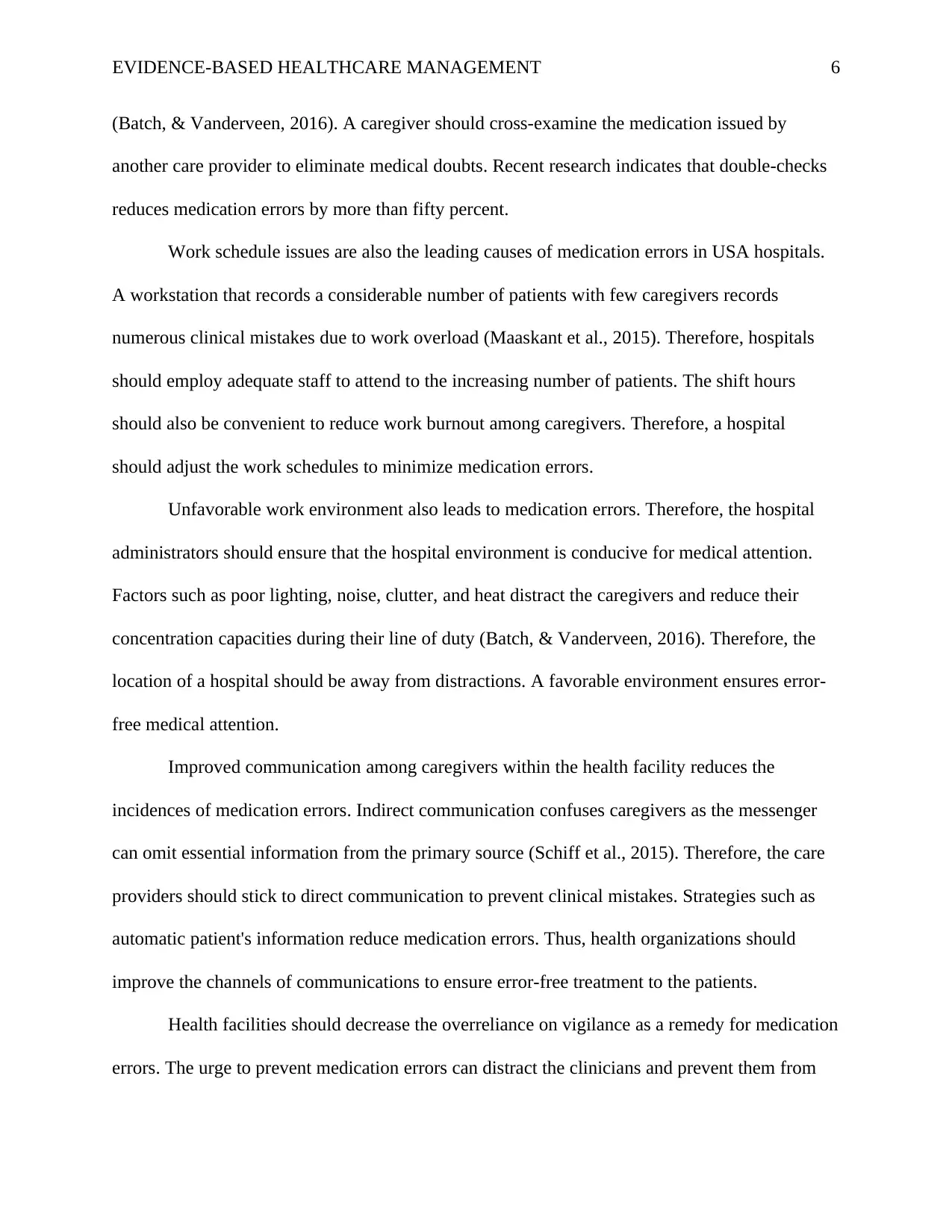
EVIDENCE-BASED HEALTHCARE MANAGEMENT 6
(Batch, & Vanderveen, 2016). A caregiver should cross-examine the medication issued by
another care provider to eliminate medical doubts. Recent research indicates that double-checks
reduces medication errors by more than fifty percent.
Work schedule issues are also the leading causes of medication errors in USA hospitals.
A workstation that records a considerable number of patients with few caregivers records
numerous clinical mistakes due to work overload (Maaskant et al., 2015). Therefore, hospitals
should employ adequate staff to attend to the increasing number of patients. The shift hours
should also be convenient to reduce work burnout among caregivers. Therefore, a hospital
should adjust the work schedules to minimize medication errors.
Unfavorable work environment also leads to medication errors. Therefore, the hospital
administrators should ensure that the hospital environment is conducive for medical attention.
Factors such as poor lighting, noise, clutter, and heat distract the caregivers and reduce their
concentration capacities during their line of duty (Batch, & Vanderveen, 2016). Therefore, the
location of a hospital should be away from distractions. A favorable environment ensures error-
free medical attention.
Improved communication among caregivers within the health facility reduces the
incidences of medication errors. Indirect communication confuses caregivers as the messenger
can omit essential information from the primary source (Schiff et al., 2015). Therefore, the care
providers should stick to direct communication to prevent clinical mistakes. Strategies such as
automatic patient's information reduce medication errors. Thus, health organizations should
improve the channels of communications to ensure error-free treatment to the patients.
Health facilities should decrease the overreliance on vigilance as a remedy for medication
errors. The urge to prevent medication errors can distract the clinicians and prevent them from
(Batch, & Vanderveen, 2016). A caregiver should cross-examine the medication issued by
another care provider to eliminate medical doubts. Recent research indicates that double-checks
reduces medication errors by more than fifty percent.
Work schedule issues are also the leading causes of medication errors in USA hospitals.
A workstation that records a considerable number of patients with few caregivers records
numerous clinical mistakes due to work overload (Maaskant et al., 2015). Therefore, hospitals
should employ adequate staff to attend to the increasing number of patients. The shift hours
should also be convenient to reduce work burnout among caregivers. Therefore, a hospital
should adjust the work schedules to minimize medication errors.
Unfavorable work environment also leads to medication errors. Therefore, the hospital
administrators should ensure that the hospital environment is conducive for medical attention.
Factors such as poor lighting, noise, clutter, and heat distract the caregivers and reduce their
concentration capacities during their line of duty (Batch, & Vanderveen, 2016). Therefore, the
location of a hospital should be away from distractions. A favorable environment ensures error-
free medical attention.
Improved communication among caregivers within the health facility reduces the
incidences of medication errors. Indirect communication confuses caregivers as the messenger
can omit essential information from the primary source (Schiff et al., 2015). Therefore, the care
providers should stick to direct communication to prevent clinical mistakes. Strategies such as
automatic patient's information reduce medication errors. Thus, health organizations should
improve the channels of communications to ensure error-free treatment to the patients.
Health facilities should decrease the overreliance on vigilance as a remedy for medication
errors. The urge to prevent medication errors can distract the clinicians and prevent them from
⊘ This is a preview!⊘
Do you want full access?
Subscribe today to unlock all pages.

Trusted by 1+ million students worldwide
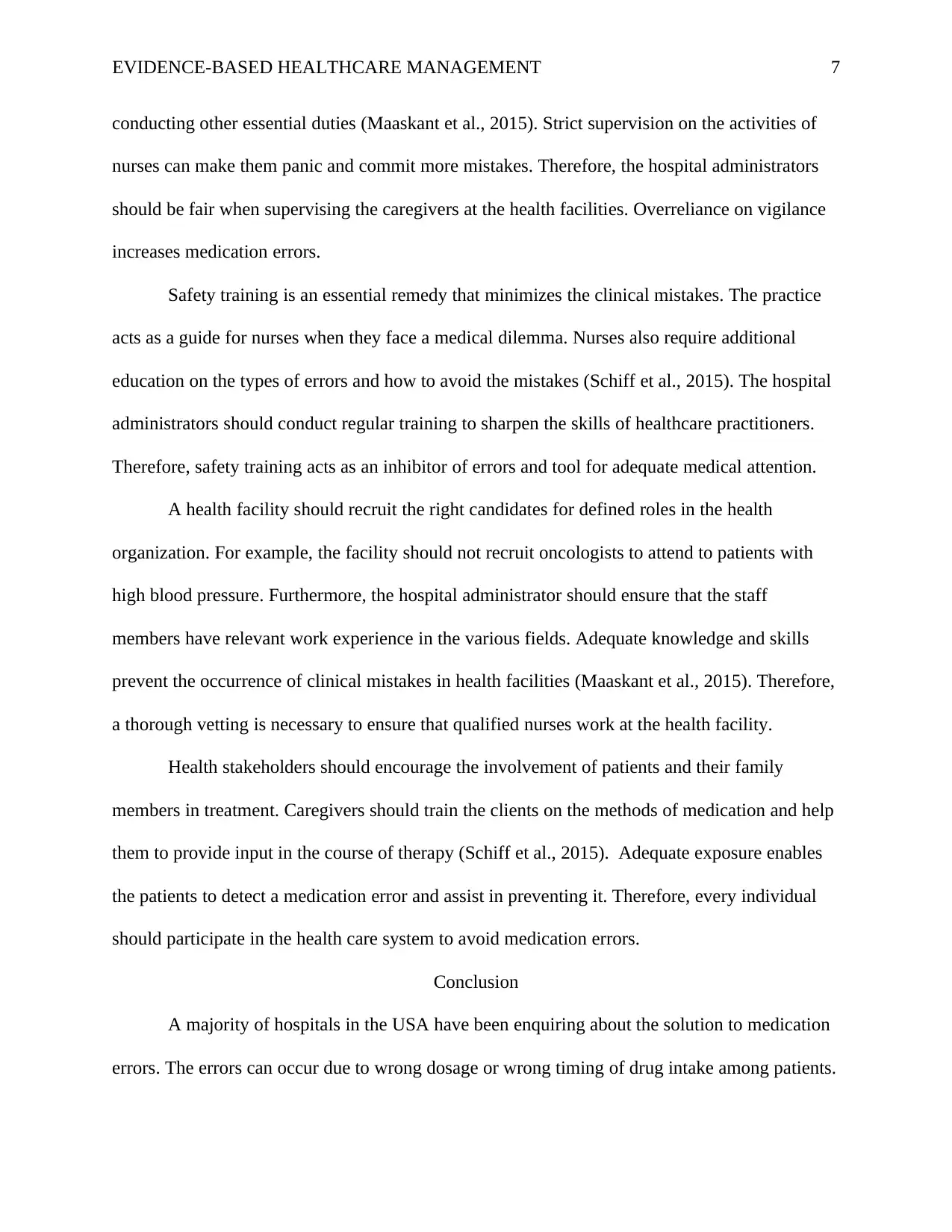
EVIDENCE-BASED HEALTHCARE MANAGEMENT 7
conducting other essential duties (Maaskant et al., 2015). Strict supervision on the activities of
nurses can make them panic and commit more mistakes. Therefore, the hospital administrators
should be fair when supervising the caregivers at the health facilities. Overreliance on vigilance
increases medication errors.
Safety training is an essential remedy that minimizes the clinical mistakes. The practice
acts as a guide for nurses when they face a medical dilemma. Nurses also require additional
education on the types of errors and how to avoid the mistakes (Schiff et al., 2015). The hospital
administrators should conduct regular training to sharpen the skills of healthcare practitioners.
Therefore, safety training acts as an inhibitor of errors and tool for adequate medical attention.
A health facility should recruit the right candidates for defined roles in the health
organization. For example, the facility should not recruit oncologists to attend to patients with
high blood pressure. Furthermore, the hospital administrator should ensure that the staff
members have relevant work experience in the various fields. Adequate knowledge and skills
prevent the occurrence of clinical mistakes in health facilities (Maaskant et al., 2015). Therefore,
a thorough vetting is necessary to ensure that qualified nurses work at the health facility.
Health stakeholders should encourage the involvement of patients and their family
members in treatment. Caregivers should train the clients on the methods of medication and help
them to provide input in the course of therapy (Schiff et al., 2015). Adequate exposure enables
the patients to detect a medication error and assist in preventing it. Therefore, every individual
should participate in the health care system to avoid medication errors.
Conclusion
A majority of hospitals in the USA have been enquiring about the solution to medication
errors. The errors can occur due to wrong dosage or wrong timing of drug intake among patients.
conducting other essential duties (Maaskant et al., 2015). Strict supervision on the activities of
nurses can make them panic and commit more mistakes. Therefore, the hospital administrators
should be fair when supervising the caregivers at the health facilities. Overreliance on vigilance
increases medication errors.
Safety training is an essential remedy that minimizes the clinical mistakes. The practice
acts as a guide for nurses when they face a medical dilemma. Nurses also require additional
education on the types of errors and how to avoid the mistakes (Schiff et al., 2015). The hospital
administrators should conduct regular training to sharpen the skills of healthcare practitioners.
Therefore, safety training acts as an inhibitor of errors and tool for adequate medical attention.
A health facility should recruit the right candidates for defined roles in the health
organization. For example, the facility should not recruit oncologists to attend to patients with
high blood pressure. Furthermore, the hospital administrator should ensure that the staff
members have relevant work experience in the various fields. Adequate knowledge and skills
prevent the occurrence of clinical mistakes in health facilities (Maaskant et al., 2015). Therefore,
a thorough vetting is necessary to ensure that qualified nurses work at the health facility.
Health stakeholders should encourage the involvement of patients and their family
members in treatment. Caregivers should train the clients on the methods of medication and help
them to provide input in the course of therapy (Schiff et al., 2015). Adequate exposure enables
the patients to detect a medication error and assist in preventing it. Therefore, every individual
should participate in the health care system to avoid medication errors.
Conclusion
A majority of hospitals in the USA have been enquiring about the solution to medication
errors. The errors can occur due to wrong dosage or wrong timing of drug intake among patients.
Paraphrase This Document
Need a fresh take? Get an instant paraphrase of this document with our AI Paraphraser
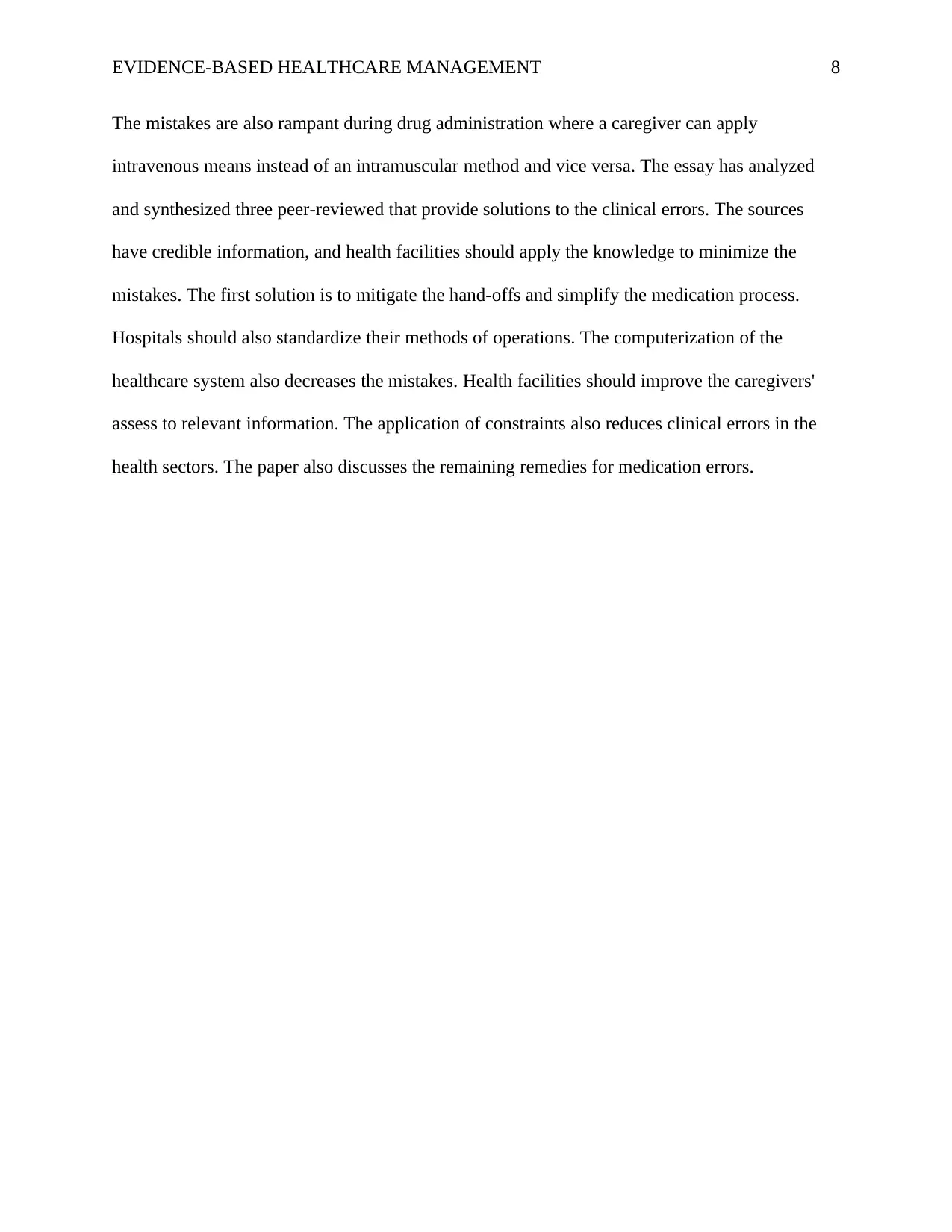
EVIDENCE-BASED HEALTHCARE MANAGEMENT 8
The mistakes are also rampant during drug administration where a caregiver can apply
intravenous means instead of an intramuscular method and vice versa. The essay has analyzed
and synthesized three peer-reviewed that provide solutions to the clinical errors. The sources
have credible information, and health facilities should apply the knowledge to minimize the
mistakes. The first solution is to mitigate the hand-offs and simplify the medication process.
Hospitals should also standardize their methods of operations. The computerization of the
healthcare system also decreases the mistakes. Health facilities should improve the caregivers'
assess to relevant information. The application of constraints also reduces clinical errors in the
health sectors. The paper also discusses the remaining remedies for medication errors.
The mistakes are also rampant during drug administration where a caregiver can apply
intravenous means instead of an intramuscular method and vice versa. The essay has analyzed
and synthesized three peer-reviewed that provide solutions to the clinical errors. The sources
have credible information, and health facilities should apply the knowledge to minimize the
mistakes. The first solution is to mitigate the hand-offs and simplify the medication process.
Hospitals should also standardize their methods of operations. The computerization of the
healthcare system also decreases the mistakes. Health facilities should improve the caregivers'
assess to relevant information. The application of constraints also reduces clinical errors in the
health sectors. The paper also discusses the remaining remedies for medication errors.
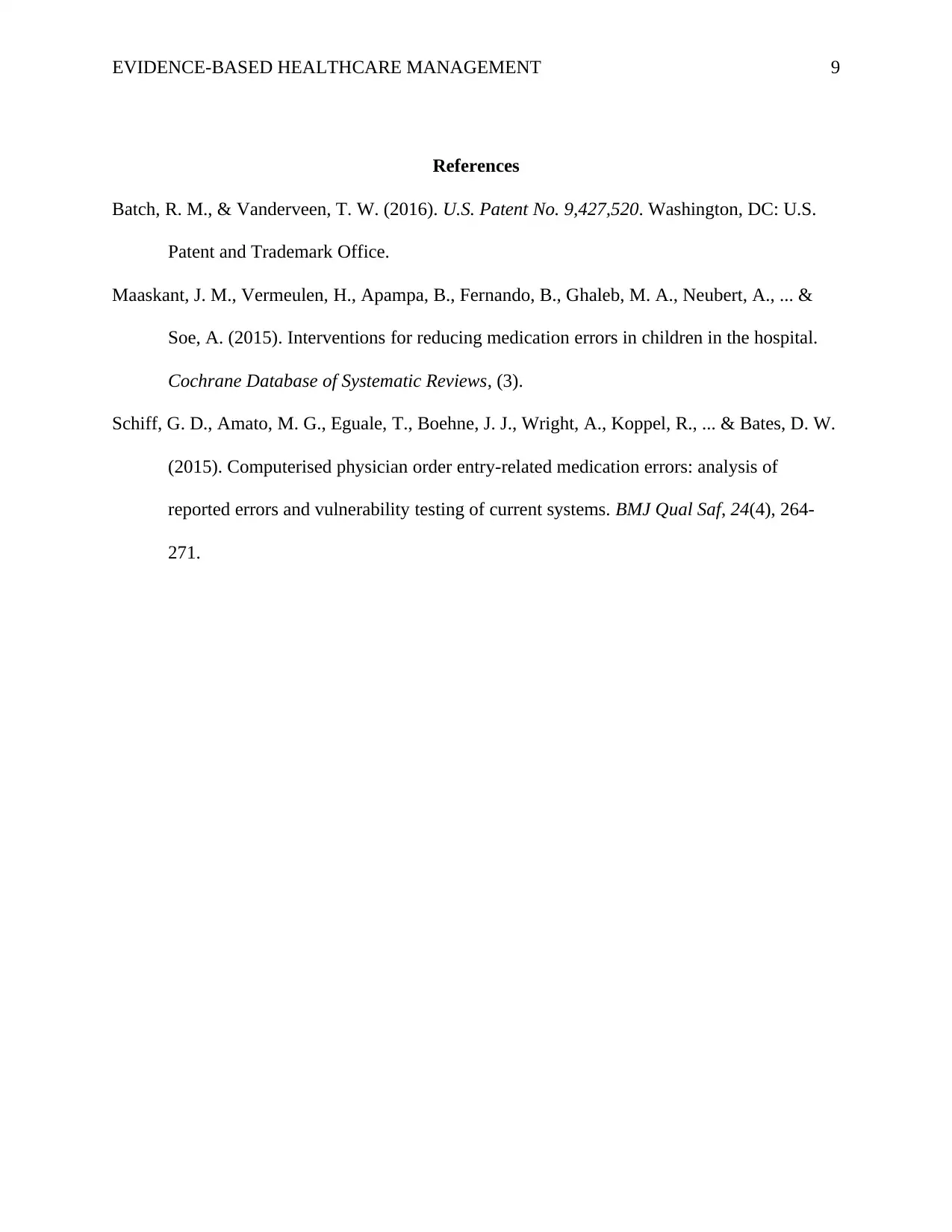
EVIDENCE-BASED HEALTHCARE MANAGEMENT 9
References
Batch, R. M., & Vanderveen, T. W. (2016). U.S. Patent No. 9,427,520. Washington, DC: U.S.
Patent and Trademark Office.
Maaskant, J. M., Vermeulen, H., Apampa, B., Fernando, B., Ghaleb, M. A., Neubert, A., ... &
Soe, A. (2015). Interventions for reducing medication errors in children in the hospital.
Cochrane Database of Systematic Reviews, (3).
Schiff, G. D., Amato, M. G., Eguale, T., Boehne, J. J., Wright, A., Koppel, R., ... & Bates, D. W.
(2015). Computerised physician order entry-related medication errors: analysis of
reported errors and vulnerability testing of current systems. BMJ Qual Saf, 24(4), 264-
271.
References
Batch, R. M., & Vanderveen, T. W. (2016). U.S. Patent No. 9,427,520. Washington, DC: U.S.
Patent and Trademark Office.
Maaskant, J. M., Vermeulen, H., Apampa, B., Fernando, B., Ghaleb, M. A., Neubert, A., ... &
Soe, A. (2015). Interventions for reducing medication errors in children in the hospital.
Cochrane Database of Systematic Reviews, (3).
Schiff, G. D., Amato, M. G., Eguale, T., Boehne, J. J., Wright, A., Koppel, R., ... & Bates, D. W.
(2015). Computerised physician order entry-related medication errors: analysis of
reported errors and vulnerability testing of current systems. BMJ Qual Saf, 24(4), 264-
271.
⊘ This is a preview!⊘
Do you want full access?
Subscribe today to unlock all pages.

Trusted by 1+ million students worldwide
1 out of 9
Your All-in-One AI-Powered Toolkit for Academic Success.
+13062052269
info@desklib.com
Available 24*7 on WhatsApp / Email
![[object Object]](/_next/static/media/star-bottom.7253800d.svg)
Unlock your academic potential
Copyright © 2020–2025 A2Z Services. All Rights Reserved. Developed and managed by ZUCOL.